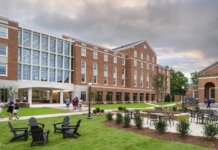
Venturing down a path of higher risk has led to a higher reward for Birmingham-based Infinity Property and Casualty Corp.
Founded in 1954, Infinity entered the 21st century as just another all-purpose insurer in a crowded field. Though the company had a presence in 42 states, Infinity’s overall scope was “average at best,” according to Glen Godwin, who joined the organization in 1986.
“It was difficult for us to have enough infrastructure to write enough policies to develop enough data to be very good,” says Godwin, who served as both CEO and chief marketing officer for Infinity. “We couldn’t generate the meaningful scale needed to derive the data necessary to make future decisions. We couldn’t create that flywheel effect of success on top of success.”
So instead of staying stuck in the middle of the road, in 2003 Infinity took a turn down a less-traveled path. The company went public and began honing its focus on 18 major urban centers in four states: California, Arizona, Florida and Texas. The emphasis was to serve customers who Godwin says “have more extensive needs” because of a variety of factors, including poor credit, poor driving records and even simply operating older vehicles.
“The industry as a whole tends to target what are considered to be low-risk individuals and areas. That is not the case in our major urban areas,” Godwin says. “So we developed an urban strategy, to be a provider that can provide quality auto insurance at affordable rates to these under-served markets.”
The strategy paid off. In less than 15 years, Infinity grew to become one of the top five among specialty auto insurers in the nation, employing approximately 2,300 people with 10,600 independent agents and writing $1.4 billion in premiums in 2017.
That growth caught the eye of Chicago-based Kemper Corp., an all-purpose insurer with more than $8 billion in assets. On July 2, Kemper closed on a $1.6 billion acquisition of Infinity, boosting the company to approximately 8,000 employees doing business in 46 states.

Godwin says the merger is a win for both companies. Kemper is able to extend its footprint into several major markets where its presence was lagging, while Infinity is able to expand into other areas of the insurance industry beyond auto.
“Historically we’ve written auto insurance and no other coverages. We were successfully growing the business that way, but we wanted to extend our customer relationship,” Godwin says. “Most of our auto insurance customers eventually bought a house or had some other insurance need. That’s how you get a customer for life.
“We saw this as a way that Kemper could leverage the success that Infinity was having, while we could offer broader insurance solutions for our customers. We weren’t looking for a financial merger. We were looking for a strategic merger.”
Kemper President and CEO Joseph Lacher Jr. says his company was especially intrigued with Infinity’s inroads into the growing Hispanic marketplace. He noted that Infinity is one of the few auto insurance companies in the United States that has representatives who are almost all bilingual in English and Spanish.
“If you’re trying to service customers whose first language is Spanish, they might be less comfortable transacting important business in English,” Lacher says. “A lot of companies hire a translation service, or they might route folks through a special (Spanish-speaking) processing queue that’s slower and less efficient.
“Infinity built a focus in the Hispanic market, where virtually all their customer-service and claim reps are bilingual. So they can communicate and transact business in English or Spanish equally comfortably. That is a huge plus for a customer whose preference is to transact business in Spanish. And it’s a competitive differentiator from the generalists.”
Infinity’s shift to a primarily urban customer base began under the leadership of former CEO James Gober. Godwin says the key was for Infinity to establish significant infrastructure within the urban areas it was serving. This allowed the company to handle almost all aspects of its business in-house, helping to offset the costs of writing higher-risk policies.
“What we noticed over time was if you just reallocated your capital to some degree and your operational investment in ways that would allow you to provide services in those areas, you could underwrite that business, price it properly and make a profit,” Godwin says. “The way we chose to do that was a heavy investment in our claims infrastructure within those urban zones.
“For example, in Los Angeles we built a claims operation that would be our largest employee count. It was comprised of adjustors, specialists in the area of material damage to autos, and a special investigation unit that would combat the fraud that’s more prevalent in urban areas.”
Infinity also established in-house legal counsel, which Godwin says was an important element in enabling Infinity to offer affordable policies for higher-risk customers.
“It’s not uncommon in our business to have the other parties suing us,” Godwin says. “Our duty is to pay fast and fairly, but also to pay what it’s worth. One of the unfortunate things of our industry is that third parties can challenge a fair settlement and look to over-utilize the insurance contract, which creates poor underwriting performance. You pay too much for a claim.
“So we have to basically negotiate and sometimes fight plaintiff attorneys for fair settlements. We found that if the attorneys worked directly for us, instead of the traditional approach where you use an independent defense firm, that we could further lower costs.”
The end result, Godwin says, was a company that could take on higher risks without negatively affecting its bottom line.
“The combination of all this infrastructure really worked to lower the cost of operating the insurance company,” Godwin says. “By changing the paradigm and being more effective in lowering our lost costs and expenses in the urban areas, we found that we could provide the product at a rate that the customer found affordable.”
It is a strategy that obviously appealed to Kemper. And now that the acquisition is complete, Lacher says the company will have even more opportunities to fill the need of under-served insurance markets.
“By combining, we add scale to both our operations, which allows us to be more efficient from an expense perspective, and have better analytic tools and better data,” Lacher says. “It allows us to be more effective in working with body shops in terms of repairing cars. All those things will allow both combined companies to provide a more competitive product suite to our customers, and do a better job delivering a higher-caliber of service.
“Scale helps both of us. And because we are two strong players in this space getting together and becoming stronger, it will give us the ability to be a more effective player in the marketplace.”
Cary Estes and Cary Norton are freelance contributors to Business Alabama. Both are based in Birmingham.



